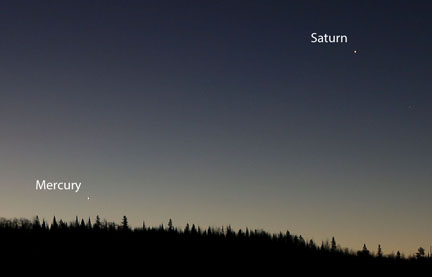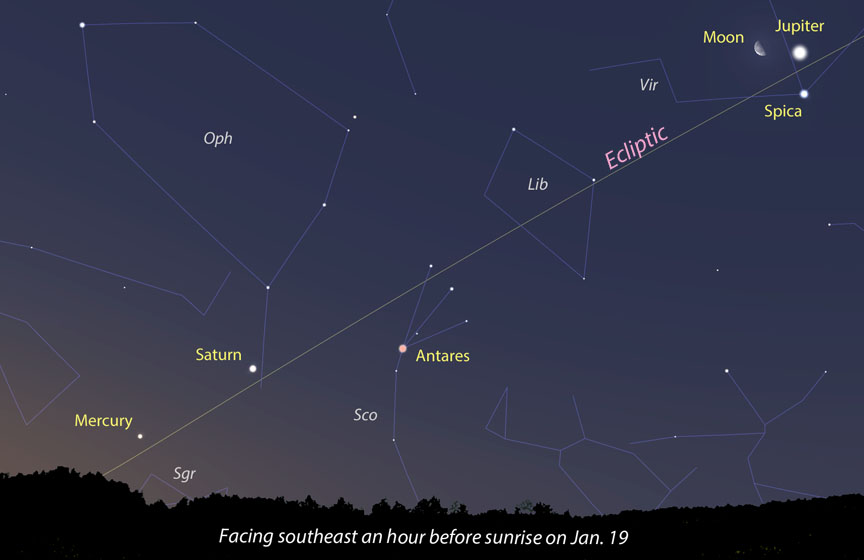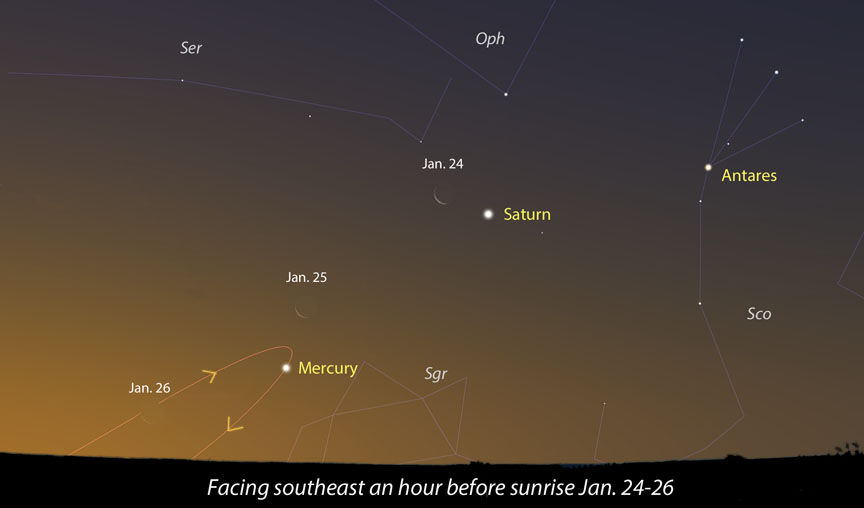Astronomy - See Mercury First, Then Have Breakfast
Late sunrises make it easy to follow the parade of planets at dawn, including a nice apparition of Mercury this week and three successive lunar conjunctions.

Planets Mercury and Saturn make a pretty pair at dawn in the southeastern sky this month. You can spot them an hour before sunrise. This photo was taken on January 15th from Duluth, Minnesota.
Bob King
Bob King
Before you know it, the Sun will come up at 5 a.m., making observing at dawn a serious loss-of-sleep experience. Now's the time to take advantage of winter's late sunrises — typically around 7:30 a.m. — to get out and look at your favorite planets or the Moon before a final cup of coffee and off to work.
The Moon slims to last-quarter phase this week and passes just 2.5° north of Jupiter on Thursday morning, January 19th. Few of us stay up late enough for a good look at the last-quarter Moon, when craters and hills cast their shadows to lunar east instead of west. After you've grown accustomed to first-quarter phase, seeing shading in reverse can be pleasantly disorienting.
Then there's the Jovian weather. A bright plume around longitude 190° (CM2) has recently appeared in the South Equatorial Belt (SEB), marking the start of a new SEB outbreak. Is the Great Red Spot still shrinking? Find out yourself Thursday morning, when it rotates squarely into view around 6:30 a.m. CST (7:30 EST, 5:30 MST, and 4:30 PST).
If all that doesn't entice you to drag out the scope, there's also this other little thing happening — Mercury's greatest western elongation.
The little planet with the big iron heart is having a decent morning apparition, reaching its greatest apparent distance west of the Sun on the 19th, the very same morning Jupiter, Spica, and the third-quarter Moon gather in conjunction high in the southern sky at dawn.

Use this map, set for 40° N latitude on January 19th, to navigate from Antares in Scorpius to Saturn, and from there to Mercury.
Map: Bob King, Source: Stellarium
Map: Bob King, Source: Stellarium
When it comes to finding Mercury, Saturn gladly lends a hand. Like Mercury, the ringed planet recently made its dawn debut after solar conjunction. Saturn, being an outer planet, gradually rises into a dark sky, while little Mercury remains closely tethered to the Sun. Catch it now, when it's tugging at the end of its leash before Sol yanks it back into the searing light of day.
Saturn rises at 5:00 a.m., but isn't an easy catch until around 6:15–6:30 a.m., when dawn blues up the eastern sky. Look for it some 10°–15° high in the southeast, a fist and a half lower left of ruddy Antares in Scorpius. Once you've located Saturn, Mercury's a snap, provided you have a good horizon. Look about one fist to the lower left (farther east) of Saturn for a similarly bright star about an hour before sunrise. Yep, that's Mercury!

Like Venus, which also orbits the Sun interior to the Earth, Mercury displays phases. In the next two weeks, the planet will gradually fill out and brighten.
Diagram: Bob King, Source: Stellarium
Diagram: Bob King, Source: Stellarium
Both planets currently shine around magnitude +0.6. I easily found Saturn from my observing site at +47° N on the 15th around 6:20 but had to wait until 6:45 (an hour before local sunrise) for Mercury to clear a line of distant trees. Both planets were obvious with the naked eye up till about 45 minutes before sunrise.
The duo was closest earlier this month with a minimum separation of about 7°. Since then, Saturn's hurried along to the west, a consequence of Earth's revolution around the Sun, with Mercury trying its best to catch up, ultimately an impossible task. They're currently 12° apart with their separation widening a degree a day until Mercury disappears in the solar glow in early February. That leaves about two weeks to catch this fleetest of planets before it reaches superior conjunction with the Sun in early March. After its solar baptism, Mercury will slip into the evening sky and put on a great show in late March–early April.

The Moon pairs up with Saturn and then Mercury next week on January 24–25. If it's clear, consider taking a photo the trio. You'll find hints on to do it below. Mercury's travels away from and back toward the Sun in January–early February are depicted in the loop at lower left.
Map: Bob King, Source: Stellarium
Map: Bob King, Source: Stellarium
But I'm getting ahead of myself. Be sure to mark your calendar for one week from now. On January 24th, the waning crescent Moon, just a few days before new, slices the evening sky next to Saturn. And on January 25th, the Moon glides some 5° north of Mercury. You may even want to take a picture of these conjunctions. To do so, you'll need a tripod and camera that can take a short time exposure. Use manual mode, focus on the lunar crescent, frame a scene, set the ISO or sensitivity to 400, set the lens aperture to f/4, and expose for 2–5 seconds.
Few people ever get to see Mercury because it requires a deliberate effort to track it down. Once you do, you'll be surprised — as I continually am — at how bright and easy it is. If you have school-aged kids, bundle them up and take them with you. They'll be up anyway and may appreciate sharing a few minutes of sky with Mom or Dad. Send them off on the bus with their heads full of planets.
No comments:
Post a Comment